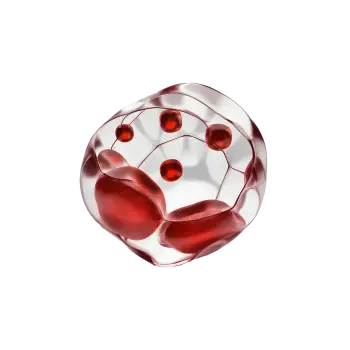Quick version
Anemia means that your body has too little hemoglobin or too few red blood cells, which leads to reduced energy and impaired oxygen transport. Common symptoms include fatigue, dizziness, paleness, and shortness of breath. In severe cases, you may experience a rapid heartbeat, cold sweats, or fainting – in such cases, seek medical care immediately.
The most common causes are iron deficiency, a lack of vitamin B12 or folate, chronic illnesses (such as kidney disease or inflammation), and in some cases, the breakdown of red blood cells (hemolytic anemia).
To find out what is causing your anemia, blood tests are necessary – not just hemoglobin, but also ferritin, iron, B12, and folate. Treatment depends on the cause: it may involve iron supplements, vitamins, or treating an underlying condition.
Do you feel constantly tired, dizzy, or pale? Take it seriously – a simple blood test can make a big difference.
Listen to Your Body’s Warning Signs
Anemia means that your body has too few red blood cells or a low level of hemoglobin – the protein that transports oxygen in the blood. When the body doesn’t get enough oxygen, it reacts quickly. Below are some key symptoms to pay special attention to:
- Fatigue and lack of energy, even after rest.
- Dizziness or feeling faint, especially when standing up.
- Shortness of breath during light physical activity.
- Heart palpitations and chest pressure.
- Pale skin and pale mucous membranes.
- Headaches and trouble concentrating.
- Cold hands and feet, sometimes feeling unusually cold.
If you suspect acute anemia – for example after heavy bleeding – your hemoglobin can drop dangerously fast, which can become life-threatening. Symptoms may include rapid heartbeat, cold sweats, difficulty breathing, or fainting. Seek medical care immediately if this occurs.
What Actually Causes Anemia?
Anemia is not a disease in itself but a sign that something is wrong in the body. It’s usually due to an imbalance between the body's need for red blood cells and its ability to produce or maintain them. There are several possible causes, from nutritional deficiencies to chronic illnesses, and an accurate diagnosis is essential for effective treatment.
Iron Deficiency – The Most Common Type
Iron deficiency anemia occurs when the body does not have enough iron to produce hemoglobin, the oxygen-carrying protein in red blood cells. This is the most common cause of anemia, especially among women of childbearing age and growing children. Iron deficiency is often associated with low levels of ferritin (which reflects the body's iron stores) and low iron in the blood, directly impacting the bone marrow’s ability to produce new red blood cells.
Common causes of iron deficiency include:
- Heavy menstruation – prolonged or intense bleeding can deplete iron stores over time.
- Pregnancy – the growing fetus requires iron, significantly increasing the mother's needs.
- Low dietary intake – common in vegetarian or vegan diets without proper planning.
- Gastrointestinal bleeding – such as ulcers, polyps, cancer, or regular use of NSAIDs (like ibuprofen), which can lead to internal bleeding.
Vitamin B12 or Folate Deficiency
Vitamin B12 and Folate B9 play a key role in the body’s cell division and the formation of red blood cells. When levels of these vitamins drop, the bone marrow’s ability to produce functional red blood cells is impaired – the cells that are formed are often too large and immature. This type of anemia is called megaloblastic anemia and results in reduced oxygen transport, even if hemoglobin levels are not initially very low.
The deficiency often develops slowly, which means symptoms can be vague – including fatigue, numbness in the feet or hands, difficulty concentrating, or a sore tongue. It is common in older adults, vegans, individuals with gastrointestinal disorders, and those taking certain medications.
- Unbalanced diet – long-term avoidance of animal products (e.g., vegan diet without B12 supplementation) increases the risk of B12 deficiency.
- Malabsorption – conditions like celiac disease, gastritis, Crohn’s disease, or gastric surgery can significantly reduce B12 and folate absorption. A lack of intrinsic factor (needed for B12 uptake) can lead to pernicious anemia.
- Medications – certain drugs interfere with absorption or metabolism of these vitamins, such as metformin (for type 2 diabetes), proton pump inhibitors (for acid reflux), and some antiepileptics.
Blood tests measuring B12, folate, and homocysteine are used to make the diagnosis. Treatment is usually straightforward – with supplements in tablet form or, in cases of absorption issues, as injections – but it is important to detect the deficiency in time to avoid long-term neurological complications.
Anemia Due to Chronic Illness
Long-term inflammation or disease can suppress red blood cell production as a protective response. This is often referred to as “anemia of chronic disease” and requires a different treatment approach than iron deficiency anemia.
- Rheumatic conditions – such as rheumatoid arthritis and lupus.
- Chronic kidney disease – the kidneys produce less of the hormone erythropoietin (EPO), which stimulates the bone marrow to produce red blood cells.
- Infections or cancer – both the illness itself and treatments (e.g., chemotherapy) can affect blood cell production.
Hemolytic Anemia
Hemolytic anemia occurs when red blood cells are destroyed faster than they can be replaced. This condition may be inherited or acquired and usually requires specialist investigation.
- Autoimmune diseases – where the immune system attacks red blood cells.
- Genetic disorders – such as sickle cell anemia or thalassemia.
- Infections, medications, or toxins – that can trigger red cell destruction.
How to Treat Anemia – Finding the Right Solution
Treating anemia always starts with identifying the underlying cause. It's not enough to simply note that hemoglobin is low – it's crucial to understand why. That’s why a range of blood tests is essential, beyond just hemoglobin. Typical analyses include ferritin (iron stores), serum iron, transferrin saturation, B12, folate, reticulocytes, and CRP. These tests help determine whether the anemia is caused by iron deficiency, functional iron deficiency (iron present but not utilized), vitamin deficiency, or chronic disease-related anemia.
Iron Deficiency Anemia
Once iron deficiency is confirmed – particularly if both ferritin and serum iron are low – treatment can begin. Sometimes transferrin saturation is also assessed to identify functional iron deficiency, where iron is stored but unavailable for blood production. Treatment usually lasts at least 2–3 months, and it’s important to continue even after symptoms improve to fully replenish iron stores.
Vitamin Deficiency
When anemia is due to low levels of vitamin B12 or folate, treatment depends on whether the deficiency is caused by poor intake or absorption issues.
- B12 deficiency – treated with oral supplements if absorption is intact, or with injections if there are absorption problems (e.g., pernicious anemia or after gastric surgery).
- Folate deficiency – treated with folic acid tablets, typically for 1–3 months depending on the severity and symptoms.
Vitamin deficiency can also occur alongside iron deficiency, making it especially important to conduct a comprehensive blood workup before starting treatment.
Anemia from Underlying Disease
If anemia is linked to a chronic condition – such as inflammation, kidney failure, or cancer – treatment focuses on addressing the root cause. In some cases, additional support may be needed:
- Treating the underlying illness – such as anti-inflammatory therapy for autoimmune disease, or EPO-stimulating therapy for kidney disease.
- Iron infusions – used in cases of functional iron deficiency or intolerance to oral iron supplements.
- Blood transfusions – may be necessary in cases of severe anemia with symptoms affecting heart or circulation.
Note: Treatment must always be individualized and followed up with repeat blood tests to ensure effectiveness.

























